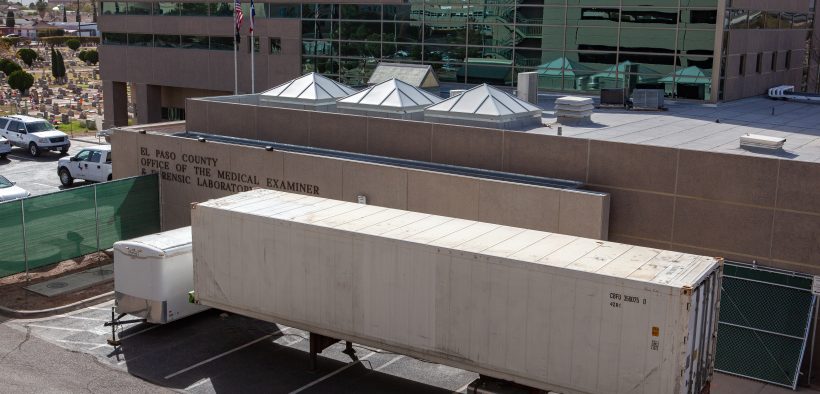The number of new COVID-19 cases in El Paso this past week dropped for the first time in two months but remains alarmingly high.
The coming days and weeks will be among the most painful in El Paso’s history, even if the decline in new cases persists.
Hospitals continue to be overwhelmed, and the novel coronavirus is killing El Pasoans at a heartbreaking rate that will only grow worse between now and the end of the year.
Here’s the weekly COVID-19 data report from El Paso Matters.
Deaths
El Pasoans are dying of COVID-19 at rates that were previously unimaginable, though it’s challenging to get precise data.
The deaths announced by El Paso health officials each day actually occurred days or weeks earlier.
A better measure of recent deaths is to look at a combination of the deaths confirmed by health officials each week and the change in deaths under investigation because they’re believed to be caused by COVID-19. Using that measure, El Paso has had more than 330 deaths in the first two weeks of November.
Over the past two weeks, El Paso has averaged more than 23 COVID-19 deaths per day. That’s how many people were killed in the Aug. 3, 2019, white supremacist terror attack in El Paso. COVID-19 has been taking a similar number of lives each day for two weeks.
The death rate almost certainly will grow higher in the coming weeks. The people dying now generally were infected in early to mid-October. The number of infections — especially among people over age 60 — has grown dramatically since then.
About 800 El Pasoans died of COVID-19 between April and October.
Another 332 El Pasoans have died in the first two weeks of November.
Based on recent infection and mortality trends, more than 1,000 additional El Pasoans may die of the disease between now and Christmas.
For context, El Paso has averaged about 450 total deaths a month in recent years.
Focus on slowing the spread by January
El Pasoans can do little to alter this predicted number of deaths over the remaining six weeks of 2020, because it involves — for the most part — people already infected with COVID-19. Our battle now is to prevent this catastrophe from repeating in January and February.
The ways to prevent this immense tragedy from continuing into the new year are straightforward.
Leave your home as little as possible, and don’t bring people from outside your household into your home. This is especially important with upcoming holidays, starting with Thanksgiving. As difficult as it is to our family-based community, El Pasoans cannot have large Thanksgiving celebrations this year.
When you leave your home, wear a face covering and stay at least six feet away from anyone who is from outside your household. If possible, have only one family member go on errands outside the home. Wash your hands frequently, especially when you leave your home.
El Paso is in a crisis, but we all can take steps to slow the spread of COVID-19 and protect our most vulnerable family members, neighbors and friends.
New cases
El Paso reported fewer than 10,000 new weekly COVID-19 cases for the first time in three weeks and registered the first week-over-week decline in eight weeks. But we are still averaging more than 1,200 new cases a day.
It’s difficult to say what is causing the decline, but it’s likely due to multiple factors.
County Judge Ricardo Samaniego’s stay-at-home order at the end of October likely had some impact, even though it was only sporadically enforced and then abandoned after restaurant owners and Texas Attorney General Ken Paxton successfully challenged the order in court.
Another factor is that the virus has fewer people it can infect. More than one in every 20 El Pasoans has tested positive since the beginning of October. Wildfires begin to slow as they have less fuel to consume.
The next two weeks will be a test of whether El Paso can slow the spread of COVID-19. The most stringent of the county judge’s mobility restrictions are no longer in force. And the Thanksgiving holiday represents huge risks if El Pasoans bring together multiple households for celebrations.
Impact on older El Pasoans
Infections among El Pasoans 60 and older — the age group most at risk for complications of COVID-19 — have grown at a horrifying rate. More people in that age group were infected in the first two weeks of November than in the entire month of October.
Those October infections are what overwhelmed our hospitals and are driving up our death rate. The infection rates among older El Pasoans for the first two weeks of November indicate that our current crisis will continue a least through the end of the year.
Hospitals
The number of COVID-19 patients sick enough to require care in hospitals and intensive care units remains well beyond the normal capacity of our hospitals. That capacity has been boosted by an influx of more than 1,000 health-care workers by the state and federal governments.
But that influx probably isn’t sustainable as COVID-19 cases spread rapidly elsewhere in the country. Some of those extra resources will soon have to be dispatched to new hotspots.
This article first appeared on El Paso Matters and is republished here under a Creative Commons license.”


